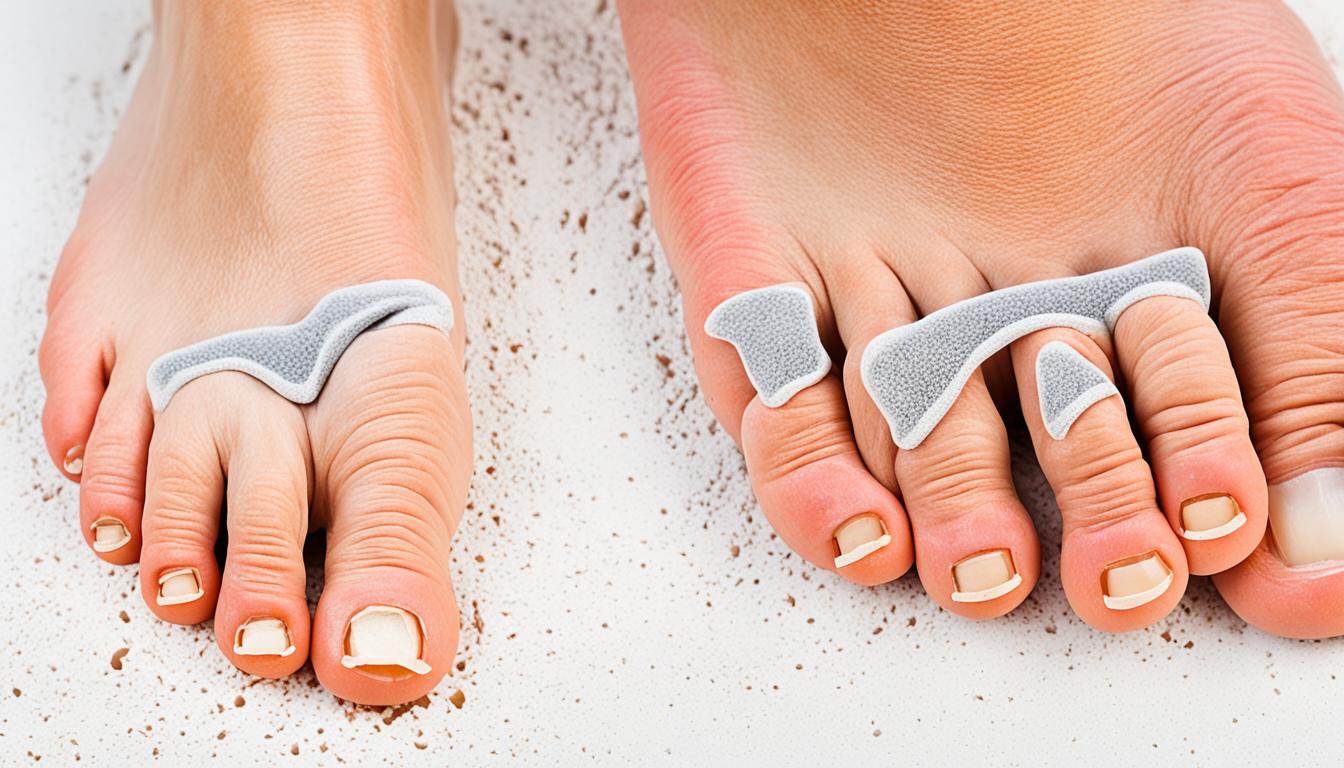Corns and calluses are often on our feet and can be painful. These thickened areas of skin appear when our skin tries to protect itself from pressure or rubbing, usually on the foot’s bottom. Wearing shoes that don’t fit well, having no cushioning, and pressure on certain joints can make them form.
They may feel hard or soft and can have a deep core. Trying to remove them at home could cause problems, though. It’s better to see a foot specialist, a podiatrist. Also, without fixing what’s causing them, corns and calluses might come back.
There are new ways to treat foot problems like corns and calluses. Stem cell therapy is one of these breakthrough treatments. It helps by attacking the root of the issue and boosting the foot’s natural healing.
Key Takeaways:
- Corns and calluses develop as a protective response to pressure or friction.
- Ill-fitting shoes, lack of cushioning, and overlying joints are common causes.
- Attempting to cut or medicate corns at home can lead to complications.
- Stem cell therapy is an innovative treatment option for corns and calluses.
- Addressing the underlying cause is crucial to prevent reoccurrence.
Symptoms and Diagnosis of Corns and Calluses
Understanding the symptoms and getting a correct diagnosis for corns and calluses is key. This knowledge is essential for proper treatment. Learning about the signs and knowing when to see a pro can really help. In this section, we’ll talk about how these issues show up and how doctors spot them.
Symptoms of Corns and Calluses
Corns and calluses often appear as thick, rough patches of skin on your feet. These spots might hurt when you walk. They can feel like you’re stepping on a small rock. Corns might even have a hard center or core.
Getting a Diagnosis
A podiatrist can diagnose these issues. They do this by looking at your feet and hearing about your health history. During the check-up, they examine the thick skin to confirm if it’s a corn or a callus. They might also ask about your shoes and daily activities. This helps understand what might be causing these foot problems. Sometimes, the doctor needs to do extra tests to be sure about the diagnosis.
If you have poor blood flow, thin skin, or nerve problems, it’s crucial to see a doctor first. They have special needs and risks that must be considered. Doing so can prevent further issues.
It’s very important not to treat corns and calluses yourself. Directly applying products from the pharmacy is a no-go. Getting checked by a professional first is the right choice. Doctors can offer the best care and prevent problems from coming back.
Treating corns and calluses early leads to better outcomes. In the next section, we’ll look at treatments and steps to stop them from returning. This will help you manage your foot health better and reduce discomfort.
Treating and Preventing Corns and Calluses
Corns and calluses are not only uncomfortable but also unsightly. Luckily, there are many treatments and ways to prevent them. Managing your feet right can keep them healthy and corns and calluses free.
Treatment Options
To treat corns and calluses, you have many options. Good foot hygiene is crucial. This means washing and drying your feet well, especially in corn and callus areas.
It’s also vital to wear shoes that fit right. Choose ones that have enough support and space for your toes. This stops pressure and reduces rubbing, which causes corns and calluses.
If you have corns or calluses already, podiatrists can remove them in their offices. These methods are both safe and provide instant ease. Your podiatrist can also help you stop them from coming back.
Home remedies are also available. Soaking your feet in warm water softens the skin, making it easier to remove the corns or calluses. Use a pumice stone or a fingernail file to gently remove the dead skin. Don’t forget to moisturize your skin to keep it soft and prevent dryness.
Prevention Techniques
Preventing corns and calluses is the best way to keep your feet healthy. Here’s how:
- Wear properly fitting shoes that offer good support and cushioning.
- Use padding, such as silicone toe sleeves or moleskin, to reduce friction on the skin.
- Avoid wearing high heels or shoes with narrow toe boxes for prolonged periods.
- Maintain good foot hygiene by washing and drying your feet regularly.
- Moisturize your feet daily to keep the skin soft and supple.
- Keep your toenails trimmed and avoid cutting them too short to prevent ingrown toenails.
| Treatment Options | Advantages | Disadvantages |
|---|---|---|
| In-office procedures | – Immediate relief | – May require multiple visits |
| Home remedies | – Convenient | – Time-consuming |
| Proper foot care | – Effective preventive measure | – Requires consistent effort |
By making these tips a part of your daily life and handling problems right away, you can have feet that are both happy and healthy.
Conclusion
Corns and calluses are often painful foot problems. They come from wearing shoes that don’t fit well. Also, they can be made worse by not keeping your feet clean.
To keep these problems away, wear shoes that fit right. Also, be sure to wash and dry your feet well. This helps stop corns and calluses from forming.
If you already have corns or calluses that hurt, see a foot doctor. They know how to take care of these issues. They may remove the corns or calluses for quick relief.
But, there’s also a new way to treat them – with stem cell therapy. This treatment uses your own body’s cells to help heal your feet. It’s a modern approach that aims for lasting results.

